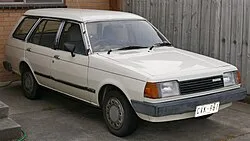

Mazda 323 Generation 1 Overview
Explore the Mazda 323 generation 1 features and specifications. Discover everything about this iconic car model generation and its significance in the automotive world.
The Mazda 323 Generation 1, also referred to as the FA series, was produced from 1977 until 1980. It marked the introduction of Mazda's compact vehicle lineup that sought to compete directly with other popular compac...
Technical Specifications
Select Version
Dimensions
Engine
Driving
Others
History and Features
Mycarro AI
Apr 27, 2025
The Mazda 323 Generation 1, also referred to as the FA series, was produced from 1977 until 1980. It marked the introduction of Mazda's compact vehicle lineup that sought to compete directly with other popular compact cars of the era. This vehicle was significant not just for its styling and features but for its contribution to Mazda’s evolving identity as a manufacturer. The FA series brought new technologies, design philosophies, and driving experiences to the market, effectively positioning Mazda as a contender in the growing compact car segment.
Design and Body Styles
The Mazda 323 FA was available in several body styles, which included a two-door coupe, a four-door sedan, and a five-door hatchback. The design of the FA generation was characterized by clean lines and modest curves, reflecting the aesthetic trends of the late 1970s. The vehicle’s compact size and nimble stance made it appealing for urban driving, and its design was both practical and stylish. The hatchback variant, in particular, became popular due to its versatility and ease of access to the cargo area, setting a standard for future hatchback models.
Engine and Performance
Under the hood, the Mazda 323 FA was equipped with a range of inline-four engines. The most common engines included a 1.4-liter and a 1.6-liter variant, both of which offered decent power and efficiency for their time. The FA generation made notable strides in fuel economy, which was becoming an important consideration for consumers during the oil crisis of the late 1970s. As a result, the Mazda 323 appealed to a demographic concerned about rising fuel prices without sacrificing performance—providing a respectable balance between power and efficiency.
Suspension and Handling
One of the standout features of the Mazda 323 FA was its impressive handling dynamics. Mazda engineered the suspension system with MacPherson struts at the front and a semi-independent system in the rear. This design provided a smooth ride while also allowing for excellent cornering capabilities. The car’s lightweight design contributed to its agility, making it fun to drive on twisty roads. Enthusiasts praised the FA generation for its engaging driving experience, a characteristic that Mazda would continue to emphasize in later models.
Interior Comfort and Features
The interior of the Mazda 323 FA was designed with a focus on comfort and practicality. While the materials used were typical of the late '70s economy cars, the overall layout was user-friendly. The dashboard featured an array of gauges that were easy to read, and the cabin provided adequate space for both passengers and cargo. Mazda included options like air conditioning, a radio, and higher trim levels that offered improved upholstery, making the FA generation a solid choice for buyers seeking a blend of affordability and comfort.
Market Reception and Legacy
Upon its release, the Mazda 323 Generation 1 was well-received in various markets, particularly in Japan and Europe. It was praised for its reliability and low operating costs, which appealed to the economically conscious consumer of the time. The FA series established a solid foundation for future iterations of the 323, and its success played a crucial role in boosting Mazda’s reputation as a maker of practical and enjoyable vehicles.
Conclusion
The Mazda 323 Generation 1 (FA) laid the groundwork for a legacy that would continue to evolve throughout the years. Its combination of stylish design, commendable performance, and comfort made it a popular choice in the compact car market during its production run. Mazda’s focus on creating a nimble and fuel-efficient vehicle helped define the brand's commitment to driving pleasure, a theme that continues to resonate within Mazda’s lineup today. The FA series set a high standard for future generations of the Mazda 323, ensuring its place in automotive history.
